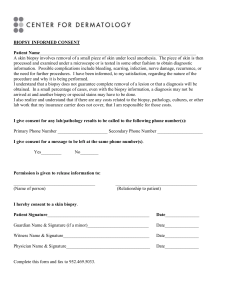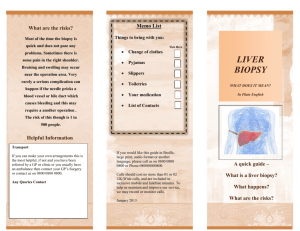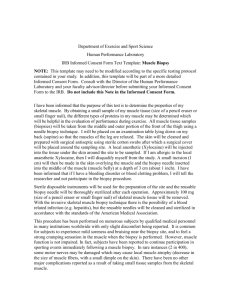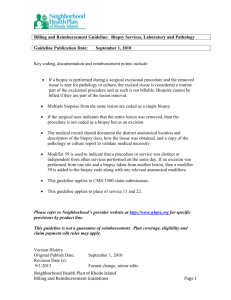Muscle Biopsy LOI 01Jul2003
advertisement
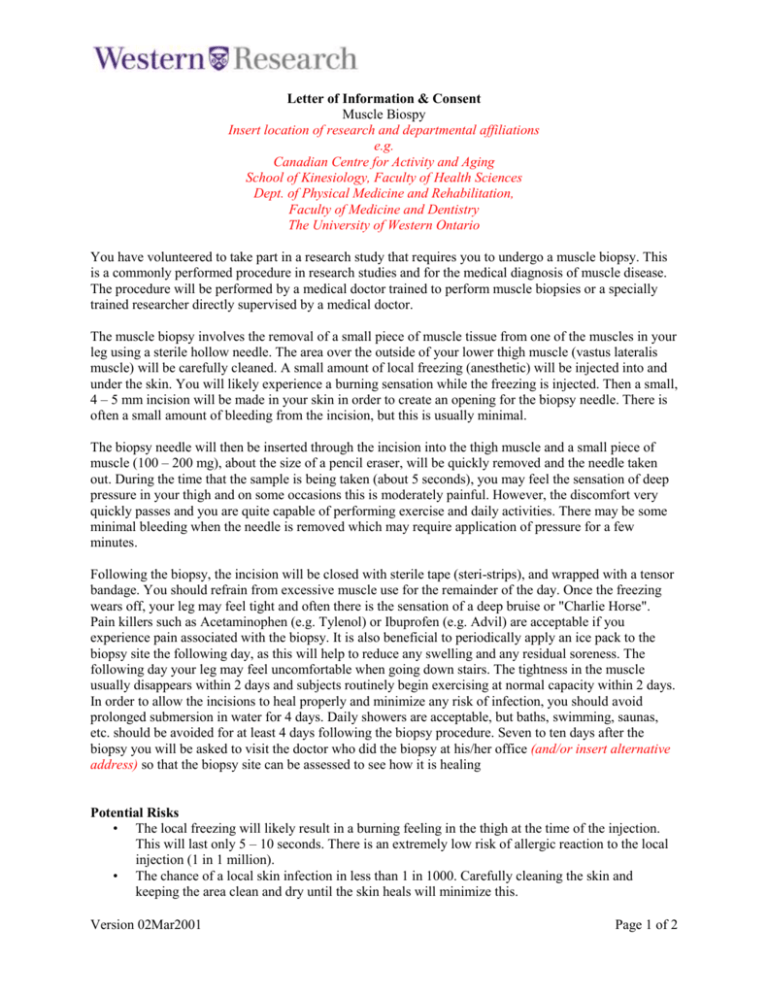
Letter of Information & Consent Muscle Biospy Insert location of research and departmental affiliations e.g. Canadian Centre for Activity and Aging School of Kinesiology, Faculty of Health Sciences Dept. of Physical Medicine and Rehabilitation, Faculty of Medicine and Dentistry The University of Western Ontario You have volunteered to take part in a research study that requires you to undergo a muscle biopsy. This is a commonly performed procedure in research studies and for the medical diagnosis of muscle disease. The procedure will be performed by a medical doctor trained to perform muscle biopsies or a specially trained researcher directly supervised by a medical doctor. The muscle biopsy involves the removal of a small piece of muscle tissue from one of the muscles in your leg using a sterile hollow needle. The area over the outside of your lower thigh muscle (vastus lateralis muscle) will be carefully cleaned. A small amount of local freezing (anesthetic) will be injected into and under the skin. You will likely experience a burning sensation while the freezing is injected. Then a small, 4 – 5 mm incision will be made in your skin in order to create an opening for the biopsy needle. There is often a small amount of bleeding from the incision, but this is usually minimal. The biopsy needle will then be inserted through the incision into the thigh muscle and a small piece of muscle (100 – 200 mg), about the size of a pencil eraser, will be quickly removed and the needle taken out. During the time that the sample is being taken (about 5 seconds), you may feel the sensation of deep pressure in your thigh and on some occasions this is moderately painful. However, the discomfort very quickly passes and you are quite capable of performing exercise and daily activities. There may be some minimal bleeding when the needle is removed which may require application of pressure for a few minutes. Following the biopsy, the incision will be closed with sterile tape (steri-strips), and wrapped with a tensor bandage. You should refrain from excessive muscle use for the remainder of the day. Once the freezing wears off, your leg may feel tight and often there is the sensation of a deep bruise or "Charlie Horse". Pain killers such as Acetaminophen (e.g. Tylenol) or Ibuprofen (e.g. Advil) are acceptable if you experience pain associated with the biopsy. It is also beneficial to periodically apply an ice pack to the biopsy site the following day, as this will help to reduce any swelling and any residual soreness. The following day your leg may feel uncomfortable when going down stairs. The tightness in the muscle usually disappears within 2 days and subjects routinely begin exercising at normal capacity within 2 days. In order to allow the incisions to heal properly and minimize any risk of infection, you should avoid prolonged submersion in water for 4 days. Daily showers are acceptable, but baths, swimming, saunas, etc. should be avoided for at least 4 days following the biopsy procedure. Seven to ten days after the biopsy you will be asked to visit the doctor who did the biopsy at his/her office (and/or insert alternative address) so that the biopsy site can be assessed to see how it is healing Potential Risks • The local freezing will likely result in a burning feeling in the thigh at the time of the injection. This will last only 5 – 10 seconds. There is an extremely low risk of allergic reaction to the local injection (1 in 1 million). • The chance of a local skin infection in less than 1 in 1000. Carefully cleaning the skin and keeping the area clean and dry until the skin heals will minimize this. Version 02Mar2001 Page 1 of 2 • • • Most subjects experience local soreness and stiffness in the leg for two or three days after the biopsy similar to a deep bruise or Charlie Horse. There is a very low risk of internal bleeding at the biopsy site which can result in more prolonged pain and stiffness in the leg. On occasion, a small lump of scar tissue may form under the site of the incision, but this normally disappears within 2-3 months, or within a few weeks if massaged. A small visible scar often remains from the biopsy incision. There is the possibility of a small area of numbness (about the size of a toonie) around the biopsy site. This usually resolves over 5 – 6 months. There is a very low risk (estimated at less than 1/5000) of damage to a small nerve branch to the muscle. This would result in partial weakness of the vastus lateralis muscle (one of four muscles that straightens the knee) and would likely have no impact on day-to-day activities. Nerve injuries like this usually resolve in 8 – 12 months, but there is a theoretical risk of mild leg weakness. Concerns or Problems Infection can be serious, if you experience excessive redness, swelling or infection around the biopsy site or pain or stiffness in your leg you must contact the doctor who did the biopsy right away. Insert name of physician doing the biopsy will be available 24 hours a day to answer any of your concerns or questions about the biopsy. Insert name & contact numbers of physician doing the biopsy: Office (519) Pager (519) However, if for some reason, you are not able to contact this physician then you should contact your family doctor or go to the Emergency Department. Please keep this Information Sheet until such time as your biopsy site has fully healed Version 02Mar2001 Page 2 of 2

